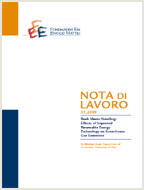Beyond the Home Market Effect: Market Size and Specialization in a Multi-Country World

05.12.2009
Kristian Behrens, Andrea R. Lamorgese, Gianmarco I.P. Ottaviano, Takatoshi Tabuchi
F12, R12
Comparative Advantage, Home Market Effect, Hub Effect, International Trade, Monopolistic Competition, Multi-country Models
Economy and Society
Gianmarco I.P. Ottaviano
The standard two-country model of international trade with monopolistic competition predicts a more-than-proportional relationship between a country’s share of world production of a good and its share of world demand for that same good, a result known as the “home market effect”. We first show that this prediction does not generally carry through to the multi-country case, as production patterns are crucially affected by third country effects. We then derive an alternative prediction that holds whatever the number of countries considered. This new prediction takes into account important features of the real world such as comparative advantage due to cross-country technological differences and lack of factor price equalization.
